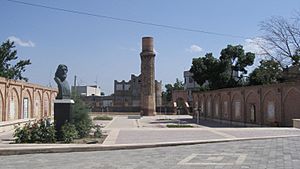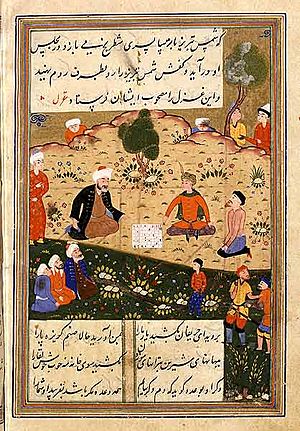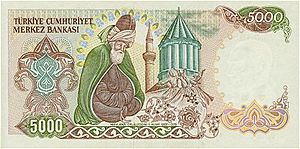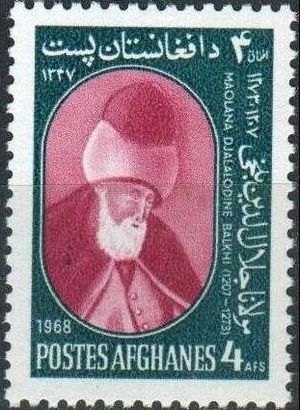Rumi facts for kids
Quick facts for kids Rumi |
|
|---|---|
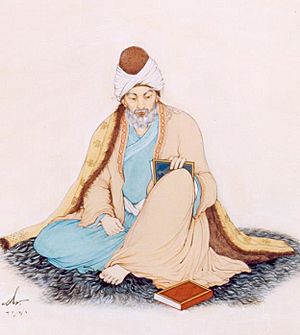
Rumi as depicted by Iranian artist Hossein Behzad (1957)
|
|
| Religion | Islam |
| Denomination | Sunni |
| Personal | |
| Born | 30 September 1207 Balkh (present-day Afghanistan) or Vakhsh (present-day Tajikistan), Khwarezmian Empire |
| Died | 17 December 1273 (aged 66) Konya (present-day Turkey), Sultanate of Rum |
| Resting place | Tomb of Mevlana Rumi, Mevlana Museum, Konya, Turkey |
| Children | Sultan Walad |
| Senior posting | |
| Title | Mevlânâ, Mawlānā, Mevlevî, Mawlawī |
| Religious career | |
| Works | Mathnawī-ī ma'nawī, Dīwān-ī Shams-ī Tabrīzī, Fīhi mā fīhi |
| Influenced | Jami, Shah Abdul Latif Bhittai, Kazi Nazrul Islam, Abdolhossein Zarrinkoob, Abdolkarim Soroush, Hossein Elahi Ghomshei, Muhammad Iqbal, Hossein Nasr Yunus Emre, Eva de Vitray-Meyer-ovitch, Annemarie Schimmel |
Jalāl al-Dīn Muḥammad Rūmī (Persian: جلالالدین محمد رومی), often called simply Rumi, was a famous Persian poet and Sufi mystic who lived in the 13th century. He was born on September 30, 1207, and passed away on December 17, 1273. Rumi's ideas and poems have touched people all over the world for more than 700 years.
His writings are mostly in Persian, but he also used Turkish, Arabic, and Greek in some of his poems. His most famous work is the Masnavi, a very long poem written in Konya, which is seen as one of the greatest poems in the Persian language. Today, Rumi's works are read widely in their original language and in many translations. He is known as one of the most popular poets in the United States.
Contents
Understanding Rumi's Name
Rumi is the name he is most commonly known by in English. His full name was Jalāl ad-Dīn Muḥammad Rūmī (جلالالدین محمد رومی).
- Jalal ad-Din means "Glory of the Faith" in Arabic.
- Balkhī means "from Balkh", which was his birthplace.
- Rūmī means "from Rûm". This refers to the area of Anatolia (modern-day Turkey), which was once part of the Byzantine (Eastern Roman) Empire. Even after Muslims took control, people still called it Rum.
He was also known as "Mullah of Rum" (ملای روم). In Iran, he is widely called Mawlānā (Persian: مولانا), which means "our master" in Arabic. In Turkey, people call him Mevlânâ. Another common name for him is Mawlawī (مولوی), meaning "my master".
Rumi's Life Story
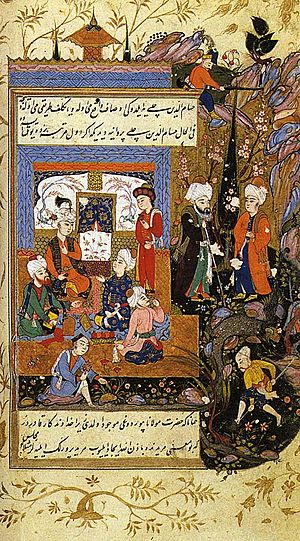

Early Life and Travel
Rumi was born in Wakhsh, a village in what is now Tajikistan. His parents spoke Persian. His father, Bahâ' uddîn Walad, was a well-known preacher and religious scholar.
At that time, the city of Greater Balkh was a big center for Persian culture and Sufism. Sufism is a mystical branch of Islam focused on finding God through personal experience. Rumi was greatly influenced by two Persian poets, Attar and Sanai. Rumi once said, "Attar was the spirit, Sanai his eyes twain, And in time thereafter, Came we in their train."
When Rumi was young, the Mongols invaded Central Asia. Because of this, his family and their followers moved west. They traveled through many cities, including Baghdad and Damascus, and even went on a pilgrimage to Mecca.
During their journey, a famous story says that Rumi met the poet Attar in the city of Nishapur. Attar saw Rumi and his father and said, "Here comes a sea followed by an ocean," recognizing Rumi's future greatness. Attar gave Rumi a book called Asrārnāma, which deeply affected the young Rumi.
The family finally settled in Karaman for seven years. In 1225, Rumi married Gowhar Khatun. They had two sons, Sultan Walad and Ala-eddin Chalabi. After his first wife passed away, Rumi married again and had another son and a daughter.
In 1228, Rumi's family moved to Konya, in Anatolia (modern-day Turkey). This was at the invitation of the ruler of Anatolia, 'Alā' ud-Dīn Key-Qobād.
Becoming a Teacher
Rumi's father became the head of a religious school. When his father died, Rumi, who was 25, took over his position. One of his father's students, Sayyed Burhan ud-Din Muhaqqiq Termazi, continued to teach Rumi about Islamic law (Sharia) and Sufism. Rumi studied with him for nine years.
After his teacher died, Rumi began his public life. He became an Islamic Jurist, giving legal opinions (fatwas) and sermons in mosques. He also taught students in the religious school.
Meeting Shams-e Tabrizi
A very important event in Rumi's life was meeting a wandering dervish named Shams-e Tabrizi on November 15, 1244. This meeting completely changed Rumi. He went from being a respected teacher to a deeply spiritual person focused on God.
Shams had been searching for someone who could understand his spiritual journey. When he met Rumi, they formed a very close and intense friendship. Rumi spent all his time with Shams, learning and growing spiritually.
Sadly, Shams disappeared on December 5, 1248, and was never seen again. It is believed he was murdered. Rumi was heartbroken by Shams's disappearance and expressed his sadness and love in many poems, which were collected in a book called Divan-e Shams-e Tabrizi.
Later Life and Legacy
After Shams, Rumi found another close friend in Salaḥ ud-Din-e Zarkub, a goldsmith. After Salaḥ ud-Din's death, Rumi's student, Hussam-e Chalabi, became his companion.
Hussam encouraged Rumi to write a long poem like those by Attar and Sanai. Rumi spent the next 12 years dictating his most famous work, the six-volume Masnavi, to Hussam.
Rumi passed away on December 17, 1273, in Konya. People from all religions in Konya, including Christians and Jews, came to mourn his death. He was buried next to his father. A beautiful shrine, the Yeşil Türbe (Green Tomb), was built over his grave. Today, this shrine is known as the Mevlana Museum and is a popular place for people to visit.
Rumi's close friend, Georgian princess and queen Gurju Khatun, helped pay for his tomb. After Rumi's death, his followers and his son, Sultan Walad, started the Mevlevi Order. This order is famous for its special spiritual dance called the Whirling Dervishes.
Rumi's Teachings and Ideas
Rumi's poetry is full of the idea of love that connects everything in the world. He believed that true love for God helps people understand the oneness of God. He taught that this love can burn away everything except the "Everlasting Beloved" (God).
Rumi's famous poem from the Masnavi shows his belief in spiritual growth:
|
از جمادی مُردم و نامی شدم |
I died to the mineral state and became a plant, |
The Masnavi uses stories, everyday scenes, and teachings from the Qur'an to explain deep spiritual ideas.
Rumi strongly believed that music, poetry, and dance were ways to connect with God. He felt that music helped people focus completely on the divine. This intense focus could make the soul feel both "destroyed" and "reborn." This idea led to the practice of the whirling Dervishes.
His teachings became the foundation for the Mevlevi Order, which his son Sultan Walad helped organize. Rumi encouraged Sama, which means listening to music and performing the sacred turning dance. In the Mevlevi tradition, samāʿ is a spiritual journey. It represents a seeker turning towards truth, growing through love, letting go of their ego, finding truth, and reaching perfection. After this journey, the seeker returns with more wisdom to serve all of creation, no matter their beliefs or background.
Rumi's favorite musical instrument was the ney, a type of reed flute.
Rumi's Major Works
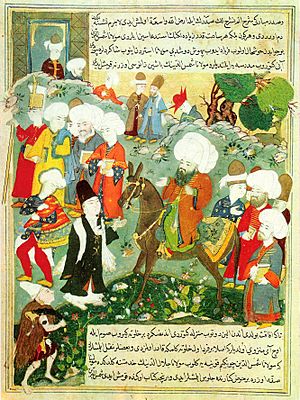
Rumi's writings are divided into poetry and prose (regular writing).
Poetic Works
- The Masnavi (Maṭnawīye Ma'nawī): This is Rumi's most famous work, meaning "Spiritual Couplets." It is a six-volume poem with about 27,000 lines. Many people call it "the Quran in Persian" because of its spiritual depth. It is considered one of the greatest mystical poems in the world.
- The Divan-e Shams-e Tabrizi (Dīwān-e Kabīr): This "Great Work" is named in honor of Rumi's teacher, Shams-e Tabrizi. It contains thousands of Persian poems, including odes (ghazals) and quatrains (rubayāt). It also includes some poems in Arabic, Turkish, and Greek.
Prose Works
- Fihi Ma Fihi (In It What's in It): This book is a collection of 71 talks and lectures Rumi gave to his students. Rumi did not write it himself; his students wrote down his words. It is written in a simple, everyday style.
- Majāles-e Sab'a (Seven Sessions): This book contains seven sermons or lectures Rumi gave in different gatherings. These sermons explain the deeper meanings of the Qur'an and Hadith (sayings of Prophet Muhammad).
- Makatib (The Letters): This is a collection of letters Rumi wrote to his students, family, and important leaders. These letters show how busy Rumi was helping his community. The letters are written in a more formal and polite style, as they were sent to important people.
Rumi's Universal Message
Rumi's teachings go beyond any single religion or group. He is known for his message of love and unity. Many people in the Western world find his teachings a great way to learn about Sufism.
His ideas teach us that people from all backgrounds can live together peacefully. Rumi's words help us find inner peace and happiness, which can lead to global peace and understanding.
Rumi's works have been translated into many languages, including Russian, German, Turkish, Arabic, and Spanish. His poetry is very popular, especially in the United States, where books of his poems have sold millions of copies. Famous artists like Madonna and Goldie Hawn have even performed his poems.
Rumi and his tomb were even shown on the 5000 Turkish lira banknotes from 1981 to 1994. In India, there is a famous landmark called Rumi Gate in Lucknow, named after him.
The Mevlevi Sufi Order and Turkey
The Mevlevi Sufi order was started in 1273 by Rumi's followers after he passed away. His son, Sultan Walad, became the leader of the order. The leadership has stayed within Rumi's family in Konya ever since.
The Mevlevi Sufis are also known as the Whirling Dervishes. They perform a special spiritual dance called Sama. This dance is a mystical journey where they turn in circles to connect with God. Rumi himself encouraged these musical and turning practices.
Rumi's favorite instrument was the ney (reed flute). Music is a very important part of the Mevlevi tradition.
The Mevlevi order welcomes people from all backgrounds with its famous invitation:
Come, come, whoever you are,
Wanderer, idolater, worshiper of fire,
Come even though you have broken your vows a thousand times,
Come, and come yet again.
Ours is not a caravan of despair.

In 1925, the Turkish government closed all dervish lodges and banned their ceremonies. However, in 1927, Rumi's Mausoleum in Konya was allowed to reopen as a museum.
In the 1950s, the Turkish government began allowing the Whirling Dervishes to perform once a year in Konya. The Mevlânā festival is held every December, ending on December 17, which is the anniversary of Rumi's death. This night is called Šabe Arūs (Persian for "nuptial night"), meaning the night of Rumi's spiritual union with God.
In 2005, UNESCO recognized the Mevlevi Sama Ceremony as an important part of the world's cultural heritage.
Celebrating Rumi's Legacy
In Afghanistan, Rumi is known as Mawlānā. In Turkey, he is Mevlâna, and in Iran, he is Molavī.
In 2007, UNESCO celebrated the 800th anniversary of Rumi's birth. They even created a medal in his name to encourage people to study and share his ideas of peace.
On September 30, 2007, school bells rang across Iran to honor Rumi. Iran also held a "Rumi Week" with conferences and events. In Turkey, a huge Whirling Dervish performance with 300 dervishes was broadcast live to celebrate his birthday.
A journal called the Mawlana Rumi Review is published every year. It aims to share Rumi's important works and ideas with the world, showing that his writings are as important as those of famous Western writers like Dante and Shakespeare.
See also
 In Spanish: Yalal ad-Din Muhammad Rumi para niños
In Spanish: Yalal ad-Din Muhammad Rumi para niños
General Topics
- Blind men and an elephant
- Sant Mat
- Symphony No. 3 (Szymanowski)
Poems by Rumi
- Rumi ghazal 163
On Persian Culture
- Iranian philosophy
- List of Persian poets and authors
- Persian literature
- Persian mysticism
- Tajik people
Rumi Scholars and Writers
- Hamid Algar
- Rahim Arbab
- William Chittick
- Badiozzaman Forouzanfar
- Hossein Elahi Ghomshei
- Fatemeh Keshavarz
- Majid M. Naini
- Seyyed Hossein Nasr
- Franklin Lewis
- François Pétis de la Croix
- Annemarie Schimmel
- Dariush Shayegan
- Abdolkarim Soroush
- Abdolhossein Zarinkoob
English Translators of Rumi Poetry
- Arthur John Arberry
- William Chittick
- Ravan A.G. Farhadi
- Nader Khalili
- Daniel Ladinsky
- Franklin Lewis
- Majid M. Naini
- Reynold A. Nicholson
- James Redhouse
- Shahriar Shahriari
- Shahram Shiva



